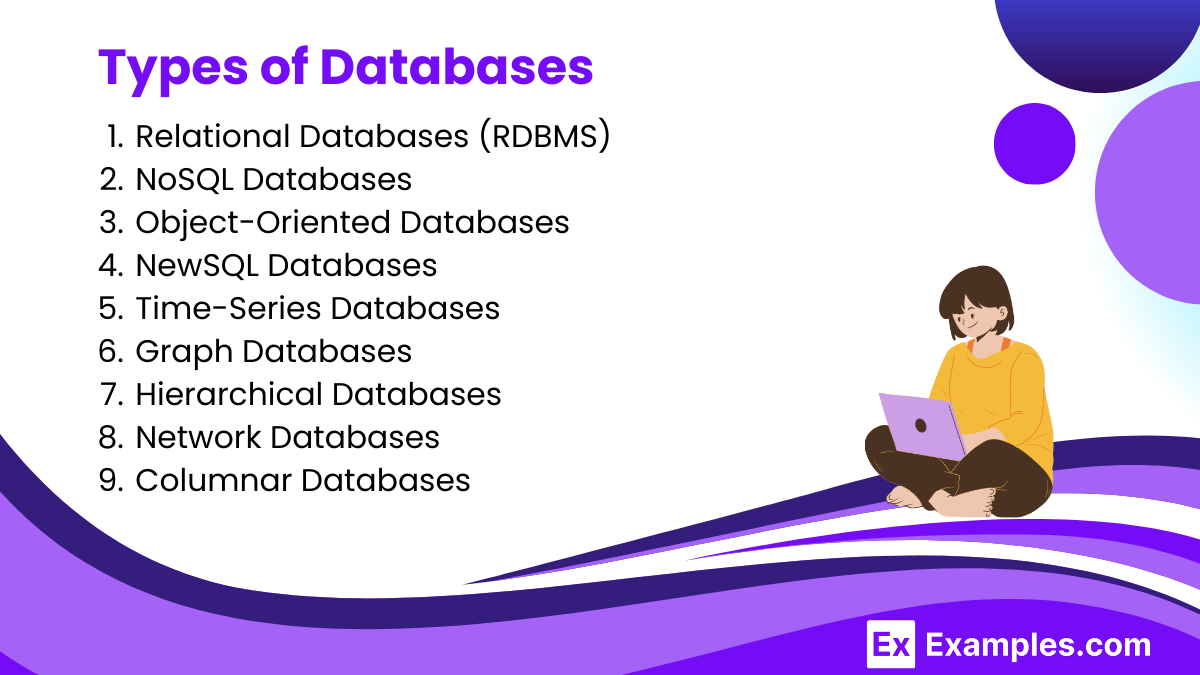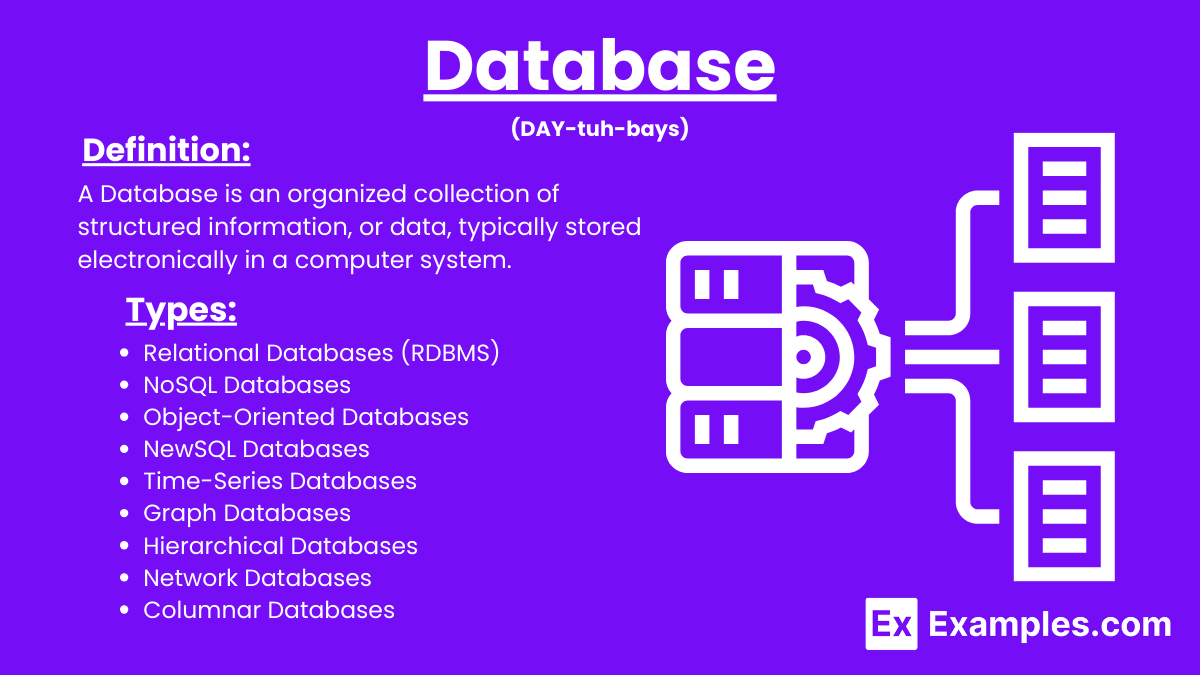15+ Database Examples to Download
A database is an organized collection of structured information, or data, typically stored electronically in a computer system. An inventory database is a specific type of database used to track and manage inventory levels, orders, sales, and deliveries. A well-structured SQL resume should highlight your experience and skills in managing databases, including creating and querying databases, designing efficient schemas, and optimizing database performance. The schema defines the structure of the database, including tables, fields, relationships, and constraints, ensuring that the data is organized and accessible.
What is Database?
What is Database Software?
Database software is a specialized application designed to create, manage, and manipulate databases. It enables users to efficiently store, retrieve, update, and delete data within a database, ensuring data integrity, security, and accessibility.
Database Management System (DBMS)
A Database Management System (DBMS) is software that enables users to define, create, maintain, and control access to databases. It provides tools for data storage, retrieval, modification, and administration, ensuring data integrity, security, and efficient management.
Examples of Database
- MySQL
- PostgreSQL
- Oracle Database
- Microsoft SQL Server
- SQLite
- MongoDB
- Redis
- Cassandra
- MariaDB
- IBM Db2
- Firebase Realtime Database
- Amazon DynamoDB
- Couchbase
- Neo4j
- Elasticsearch
MySQL Database
MySQL Database is an open-source relational database management system (RDBMS) that uses Structured Query Language (SQL) to manage and manipulate data. It is widely used for its reliability, performance, and ease of use, making it a popular choice for web applications, data warehousing, and other data-driven applications. MySQL supports a variety of operating systems and can handle large amounts of data efficiently, providing features such as data replication, multi-user access, and strong security measures.
In the context of a software quality assurance plan, MySQL’s robustness and security features are essential for ensuring that the database performs reliably and securely. When creating an online questionnaire, MySQL can be used to store and manage the collected responses effectively. For real estate businesses, MySQL can be utilized to maintain the business property listing sheet, ensuring that all property details are stored systematically and can be easily retrieved for listing and updates.
Structured Query Language (SQL)
Structured Query Language (SQL) is a standardized programming language used to manage and manipulate relational databases. SQL allows users to create, read, update, and delete data within a database. It is essential for querying data, defining database schemas, and controlling access to data. SQL commands are categorized into various types, including Data Query Language (DQL) for retrieving data, Data Definition Language (DDL) for defining database structures, Data Manipulation Language (DML) for modifying data, and Data Control Language (DCL) for controlling access to data. SQL can be effectively used for various applications, including managing a chemical inventory by organizing and maintaining records of chemical substances in a database.
Types of Databases

1. Relational Databases (RDBMS)
- Description: Organize data into tables (relations) with predefined schemas.
- Examples: MySQL, Oracle, Microsoft SQL Server.
- Use Cases: Transactional systems, enterprise applications.
2. NoSQL Databases
- Description: Designed for unstructured data, schema-less, and highly scalable.
- Types:
- Document Stores: MongoDB, CouchDB.
- Key-Value Stores: Redis, DynamoDB.
- Column-Family Stores: Cassandra, HBase.
- Graph Databases: Neo4j, ArangoDB.
- Use Cases: Big data, real-time web apps, IoT.
3. Object-Oriented Databases
- Description: Store data as objects, similar to object-oriented programming.
- Examples: ObjectDB, db4o.
- Use Cases: Applications requiring complex data representations.
4. NewSQL Databases
- Description: Combine the scalability of NoSQL with the ACID properties of traditional relational databases.
- Examples: Google Spanner, CockroachDB.
- Use Cases: Large-scale applications requiring consistency and high availability.
5. Time-Series Databases
- Description: Optimized for storing and querying time-stamped data.
- Examples: InfluxDB, TimescaleDB.
- Use Cases: IoT data, financial data, monitoring systems.
6. Graph Databases
- Description: Use graph structures with nodes, edges, and properties to represent and store data.
- Examples: Neo4j, Amazon Neptune.
- Use Cases: Social networks, recommendation systems, fraud detection.
7. Hierarchical Databases
- Description: Organize data in a tree-like structure with parent-child relationships.
- Examples: IBM’s Information Management System (IMS).
- Use Cases: Applications with a clear hierarchical relationship.
8. Network Databases
- Description: Use a graph structure but allow more complex relationships compared to hierarchical databases.
- Examples: Integrated Data Store (IDS), IDMS.
- Use Cases: Complex many-to-many relationships.
9. Columnar Databases
- Description: Store data in columns rather than rows, optimized for read-heavy operations.
- Examples: Apache HBase, Google Bigtable.
- Use Cases: Data warehousing, analytics.
Evolution of the Database
1. Early Databases (1960s-1970s)
- Hierarchical Databases: Organize data in a tree-like structure. Example: IBM’s IMS.
- Network Databases: Allow more complex relationships with a graph structure. Example: CODASYL DBTG.
2. Relational Databases (1970s-Present)
- Introduction: Concept introduced by E.F. Codd in 1970.
- Key Features: Use of tables (relations), SQL for data management.
- Examples: Oracle, MySQL, Microsoft SQL Server.
3. Object-Oriented Databases (1980s-1990s)
- Integration: Combines database capabilities with object-oriented programming.
- Features: Stores objects rather than data such as integers or strings.
- Examples: ObjectDB, db4o.
4. NoSQL Databases (2000s-Present)
- Emergence: Designed to handle unstructured data and large-scale data storage.
- Types: Document stores (MongoDB), Key-value stores (Redis), Column-family stores (Cassandra), Graph databases (Neo4j).
- Characteristics: Schema-less, distributed, scalable.
5. NewSQL Databases (2010s-Present)
- Hybrid Approach: Combine the scalability of NoSQL with the ACID (Atomicity, Consistency, Isolation, Durability) properties of traditional relational databases.
- Examples: Google Spanner, CockroachDB.
Difference between Database and Spreadsheet
| Aspect | Database | Spreadsheet |
|---|---|---|
| Purpose | To store, manage, and retrieve large amounts of structured data. | To organize, calculate, and analyze data in tabular form. |
| Data Structure | Complex, relational tables with relationships between them. | Simple, flat tables with rows and columns. |
| Data Volume | Handles large volumes of data efficiently. | Suitable for smaller data sets. |
| Data Integrity | Enforces data integrity through constraints and validation rules. | Limited data validation and integrity enforcement. |
| Querying | Uses SQL for advanced querying and data manipulation. | Limited querying capabilities, primarily uses formulas and functions. |
| Multi-User Access | Supports concurrent access by multiple users with transaction management. | Limited multi-user access, often problematic with simultaneous edits. |
| Data Relationships | Can establish and manage complex relationships between tables. | Does not inherently support relationships between tables. |
| Data Security | Offers robust security features including user permissions and encryption. | Basic security features, usually limited to password protection. |
| Automation | Supports advanced automation through stored procedures, triggers, and scripts. | Basic automation through macros and simple scripts. |
| Scalability | Highly scalable, suitable for growing data needs. | Limited scalability, performance may degrade with large datasets. |
| Backup and Recovery | Comprehensive backup and recovery options. | Basic backup and recovery, usually manual. |
| Use Case Examples | Enterprise-level applications, large-scale data analysis, and data warehousing. | Individual or small team data analysis, simple calculations, and personal finance management. |
Using Databases to improve business Performance and Decision-Making
Databases play a crucial role in enhancing business performance and facilitating informed decision-making. Here’s how they can be leveraged effectively:
1. Data Centralization
- Benefit: Consolidates all business data in one place.
- Impact: Reduces data silos, ensures data consistency, and provides a single source of truth for the organization.
2. Enhanced Data Analytics
- Benefit: Facilitates advanced data analysis.
- Impact: Helps in identifying trends, patterns, and insights that drive strategic decisions.
3. Improved Customer Relationship Management (CRM)
- Benefit: Stores comprehensive customer data.
- Impact: Enables personalized marketing, improves customer service, and boosts customer satisfaction.
4. Efficient Resource Management
- Benefit: Tracks inventory, supply chain, and resource allocation.
- Impact: Optimizes inventory levels, reduces wastage, and ensures efficient resource utilization.
5. Real-Time Data Access
- Benefit: Provides up-to-date information.
- Impact: Supports timely decision-making and enhances responsiveness to market changes.
6. Data Security and Compliance
- Benefit: Ensures secure data storage and access.
- Impact: Protects sensitive information and helps in complying with regulatory requirements.
7. Performance Monitoring
- Benefit: Monitors business processes and key performance indicators (KPIs).
- Impact: Identifies areas for improvement and tracks progress towards goals.
8. Automation of Routine Tasks
- Benefit: Automates data entry, reporting, and other routine tasks.
- Impact: Reduces manual effort, minimizes errors, and frees up time for strategic activities.
9. Scalability
- Benefit: Supports business growth.
- Impact: Easily accommodates increasing data volumes and user demands without compromising performance.
10. Enhanced Collaboration
- Benefit: Facilitates data sharing across departments.
- Impact: Promotes collaboration, improves communication, and aligns business units with overall objectives.
Database Challenges
- Data Security: Preventing unauthorized access.
- Data Integrity: Maintaining accurate data.
- Scalability: Handling growth.
- Backup and Recovery: Ensuring data safety.
- Complexity: Managing complex systems.
- Performance: Ensuring efficiency.
- Integration: Combining diverse data.
- Cost: Managing financial investment.
- Compliance: Adhering to regulations.
- User Access: Controlling permissions.
How Autonomous Technology is Improving Database Management
Autonomous technology is revolutionizing database management by automating routine tasks such as performance tuning, backup, recovery, and security management. This reduces the need for manual intervention, minimizes human error, and ensures optimal performance. Autonomous databases use machine learning and artificial intelligence to self-manage, self-repair, and self-secure, resulting in higher efficiency, reliability, and scalability. These advancements free up database administrators to focus on more strategic tasks, enhance overall system security, and reduce operational costs, making database management more efficient and effective.
Future of Databases and Autonomous Databases
The future of databases is set to be defined by the widespread adoption of autonomous databases, which leverage artificial intelligence and machine learning to self-manage, self-repair, and self-optimize. This evolution promises to drastically reduce the need for human intervention in routine database tasks, enhancing efficiency, reliability, and security. As data volumes continue to grow exponentially, autonomous databases will provide scalable solutions that adapt to changing demands in real-time. Additionally, these technologies will enable more advanced analytics, providing deeper insights and fostering innovation across various industries, ultimately transforming how businesses handle and derive value from their data.
What is a primary key?
A primary key is a unique identifier for a record in a database table, ensuring each record can be uniquely identified.
What is a foreign key?
A foreign key is a field in one table that uniquely identifies a row of another table, establishing a relationship between the tables.
What is normalization?
Normalization is the process of organizing data to reduce redundancy and improve data integrity in a relational database.
What is denormalization?
Denormalization is the process of combining tables to optimize read performance, often at the cost of data redundancy.
What is a NoSQL database?
A NoSQL database stores data in non-tabular formats like documents, key-value pairs, wide-columns, or graphs, designed for scalability and flexible data models.
What is a database schema?
A database schema defines the structure of a database, including tables, fields, relationships, and constraints.
What is an index in a database?
An index is a database object that improves the speed of data retrieval operations by providing quick access to rows in a table.
What is ACID in databases?
ACID stands for Atomicity, Consistency, Isolation, and Durability, which are properties ensuring reliable database transactions.
What is a transaction?
A transaction is a sequence of database operations that are treated as a single unit, ensuring data integrity.
What is data redundancy?
Data redundancy occurs when the same piece of data is stored in multiple places within a database, leading to potential inconsistencies.


